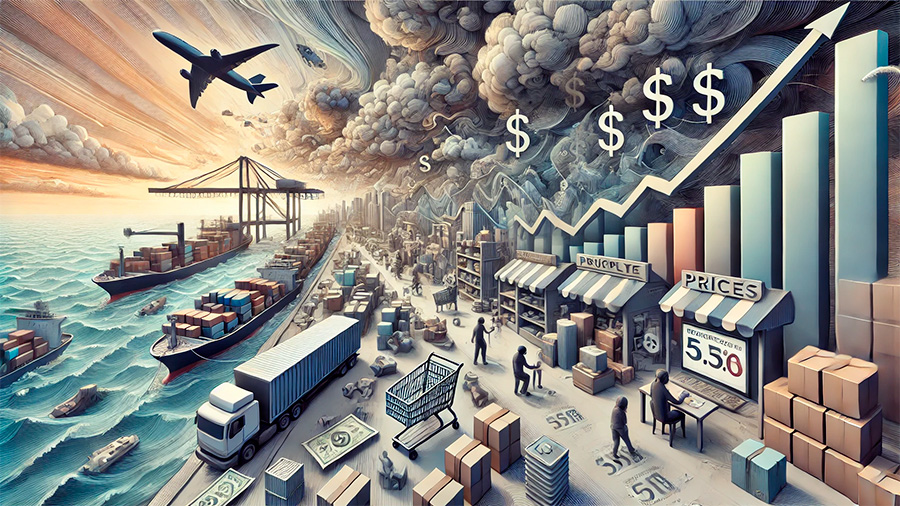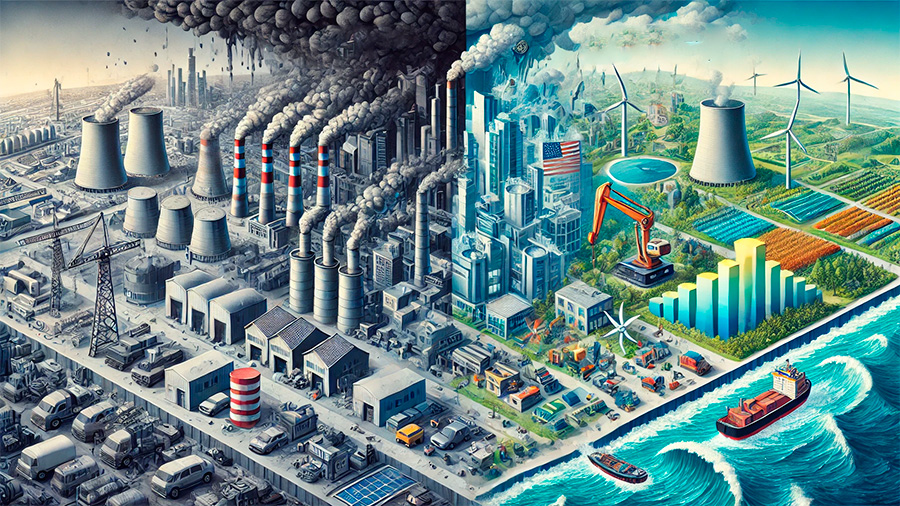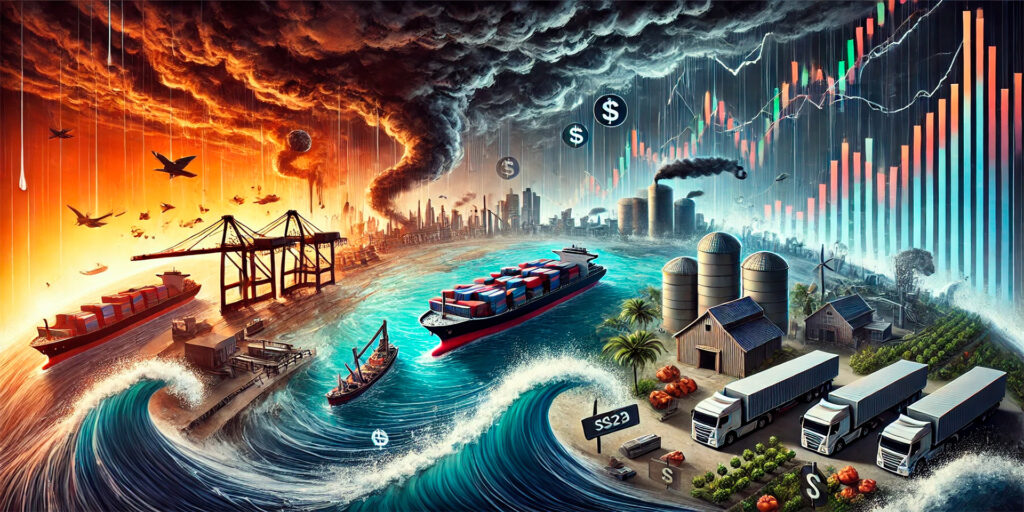Climate change is no longer a distant concern; its effects are being felt across industries, particularly in global supply chains. As extreme weather events become more frequent and environmental shifts disrupt traditional production methods, supply chains face unprecedented challenges. From delays in transportation to shortages of raw materials, the impact of climate change is evident in the rising costs of goods and increasing volatility in markets.
This article explores how climate change is disrupting supply chains globally and why it is driving up the prices of everyday goods.
The Impact of Climate Change on Supply Chains
Supply chains, particularly those dependent on agricultural production, manufacturing, and global logistics, are vulnerable to the effects of climate change. Unpredictable weather patterns, rising temperatures, and natural disasters can delay production, disrupt transportation routes, and reduce the availability of raw materials. As a result, businesses must contend with delays, inefficiencies, and increased costs throughout the supply chain, which ultimately affect consumers.
1. Extreme Weather Events and Transportation Disruptions
One of the most direct impacts of climate change on supply chains is the disruption caused by extreme weather events, such as hurricanes, floods, and wildfires. These events can destroy infrastructure, halt transportation, and damage goods in transit. Shipping routes may be blocked or delayed due to storm damage, while rail and road transport can face significant interruptions due to flooding or wildfires. These disruptions slow down the movement of goods, resulting in longer lead times and higher transportation costs.
How extreme weather impacts transportation:
- Shipping delays: Hurricanes and storms can damage ports, delay shipping routes, and slow down the global movement of goods.
- Road and rail disruptions: Floods and wildfires can block highways and railways, causing delays in delivery and increasing fuel costs for alternative routes.
2. Raw Material Shortages Due to Environmental Shifts
Climate change has altered growing seasons, water availability, and soil conditions, which directly impact the production of raw materials. Agricultural crops, such as coffee, cocoa, and grains, are particularly vulnerable to climate shifts. Droughts, floods, and unseasonable weather can reduce crop yields, leading to shortages in the global supply of essential commodities. These shortages increase the cost of raw materials, driving up prices for businesses that rely on these inputs.
How climate change affects raw material availability:
- Reduced crop yields: Unpredictable weather patterns and droughts lead to lower agricultural output, reducing the supply of essential commodities.
- Resource scarcity: Changes in water availability and soil degradation make it more difficult to grow crops and extract natural resources.

Rising Prices for Goods Due to Supply Chain Disruptions
The disruptions caused by climate change have a direct impact on the cost of goods. As businesses face delays in transportation, shortages of raw materials, and increased production costs, these expenses are passed down the supply chain to consumers. Prices for everyday items, from food products to electronics, have begun to rise as companies struggle to absorb the additional costs associated with climate-related disruptions.
1. Increased Production Costs
When raw materials become scarce due to climate-related disruptions, businesses are forced to pay more for the inputs they need to manufacture products. This leads to higher production costs, which are often passed on to consumers in the form of price increases. For example, rising prices for crops like wheat and corn can drive up the cost of bread and other staple foods, while higher costs for materials like metals and minerals can increase the price of electronics and vehicles.
Impact of higher production costs on consumer prices:
- Food price inflation: Climate-induced shortages in crops raise the cost of food products, contributing to food price inflation in global markets.
- Higher cost of manufactured goods: Increased costs for raw materials, such as metals, lead to higher prices for electronics, appliances, and vehicles.
2. Supply Chain Volatility and Price Fluctuations
Supply chains that are heavily affected by climate change are more prone to volatility and unpredictable price fluctuations. For example, when extreme weather events disrupt supply routes or destroy crops, prices for those goods can spike dramatically in a short period. This creates uncertainty for businesses and consumers alike, as prices may vary widely depending on the stability of the supply chain.
Examples of price volatility:
- Food prices: Extreme weather can lead to shortages of staple crops, driving up prices for grains, fruits, and vegetables at an unpredictable rate.
- Energy costs: Disruptions in the energy sector, caused by hurricanes or wildfires, can lead to fluctuations in fuel prices and energy bills for consumers.

Long-Term Economic Consequences of Climate Change
As climate change continues to disrupt supply chains, the long-term economic impact will become increasingly apparent. Rising prices for goods and raw materials will affect not only consumers but also businesses and economies worldwide. Companies that are unable to adapt to these disruptions may face reduced profitability, while governments may need to intervene with policies aimed at mitigating the effects of climate change on supply chains.
1. Impact on Business Profitability
Businesses that rely on global supply chains to source materials and deliver goods are particularly vulnerable to the effects of climate change. As transportation and production costs rise, many companies may struggle to maintain profitability, especially if they cannot pass on all the added costs to consumers. Additionally, businesses that do not invest in climate resilience may face operational challenges, such as prolonged production delays, that harm their long-term viability.
Challenges businesses face due to climate change:
- Rising operational costs: Increased transportation and raw material costs cut into profit margins, making it harder for businesses to remain competitive.
- Operational disruptions: Companies without contingency plans for climate-related disruptions may experience long-term production slowdowns and financial losses.
2. Government Intervention and Climate Resilience
Governments are increasingly recognizing the need to address climate change’s impact on supply chains. In response, many countries are implementing policies aimed at reducing emissions, investing in renewable energy, and promoting climate resilience in industries. By encouraging businesses to adopt sustainable practices and invest in climate-resistant infrastructure, governments hope to mitigate the long-term economic consequences of climate change on global supply chains.
Government strategies to promote climate resilience:
- Incentives for sustainable practices: Governments may offer tax breaks or subsidies for businesses that adopt renewable energy sources or sustainable farming practices.
- Infrastructure investments: Governments may invest in building more resilient transportation and energy infrastructure to withstand the effects of climate change.
Strategies for Building Climate-Resilient Supply Chains
While the effects of climate change on supply chains are significant, businesses can take steps to build resilience and reduce the impact of future disruptions. By investing in sustainable practices, diversifying suppliers, and developing contingency plans, companies can better navigate the challenges posed by climate change and ensure a more stable supply chain.
1. Investing in Sustainable Practices
Businesses can reduce their vulnerability to climate change by adopting sustainable practices that minimize their environmental impact. For example, transitioning to renewable energy sources, reducing water usage, and investing in sustainable farming methods can help businesses operate more efficiently while also reducing their carbon footprint. These practices not only improve long-term resilience but also align businesses with government policies promoting sustainability.
Examples of sustainable practices:
- Renewable energy: Transitioning to solar or wind power reduces reliance on fossil fuels and builds resilience against energy disruptions.
- Sustainable agriculture: Investing in drought-resistant crops and sustainable farming techniques can protect agricultural businesses from the effects of climate change.
2. Diversifying Suppliers and Building Contingency Plans
One of the key ways businesses can build more resilient supply chains is by diversifying their suppliers and creating contingency plans for climate-related disruptions. By sourcing materials from multiple regions and suppliers, businesses can reduce the risk of shortages due to extreme weather events in any one location. Additionally, having contingency plans in place allows companies to quickly adapt to disruptions, such as by rerouting shipments or finding alternative suppliers.
How to build climate-resilient supply chains:
- Supplier diversification: Working with suppliers in different geographic regions reduces the risk of disruptions from localized climate events.
- Contingency planning: Developing flexible supply chain strategies, such as alternative shipping routes, helps businesses adapt to unexpected disruptions.
Conclusion
Climate change is having a profound impact on global supply chains, leading to rising transportation costs, raw material shortages, and increased prices for consumer goods. As extreme weather events and environmental shifts become more frequent, the long-term economic consequences of climate change will continue to disrupt global markets. However, by investing in sustainable practices and building more resilient supply chains, businesses can mitigate the effects of climate change and ensure their operations remain stable in the face of environmental challenges.



